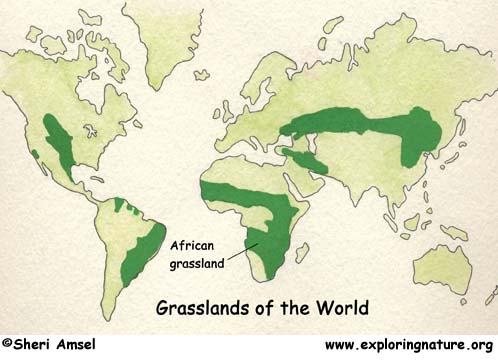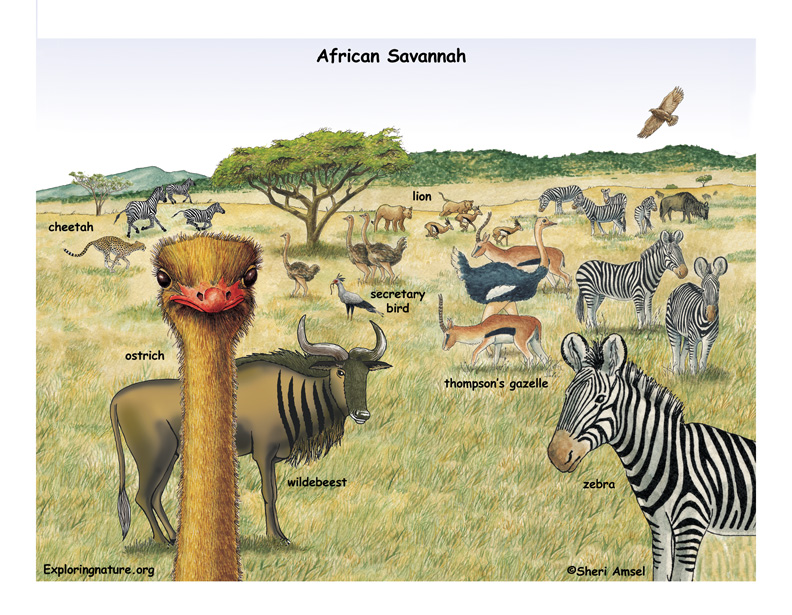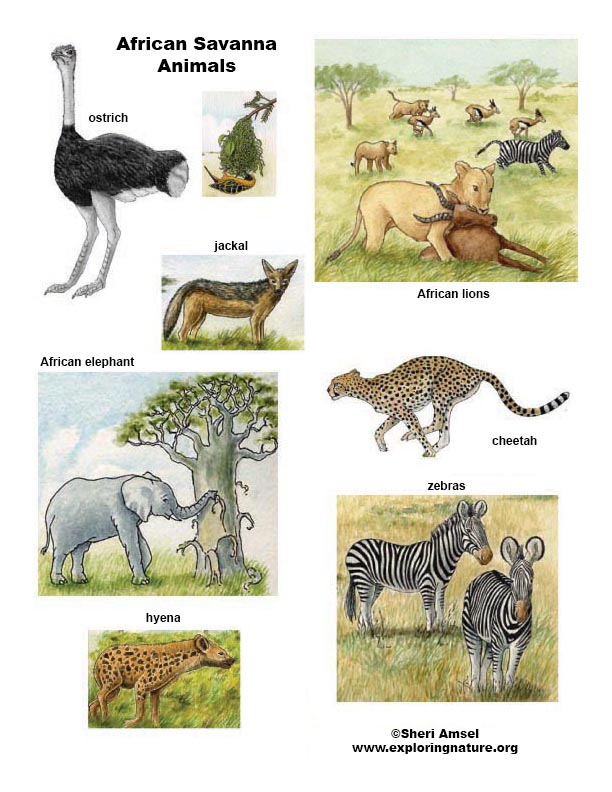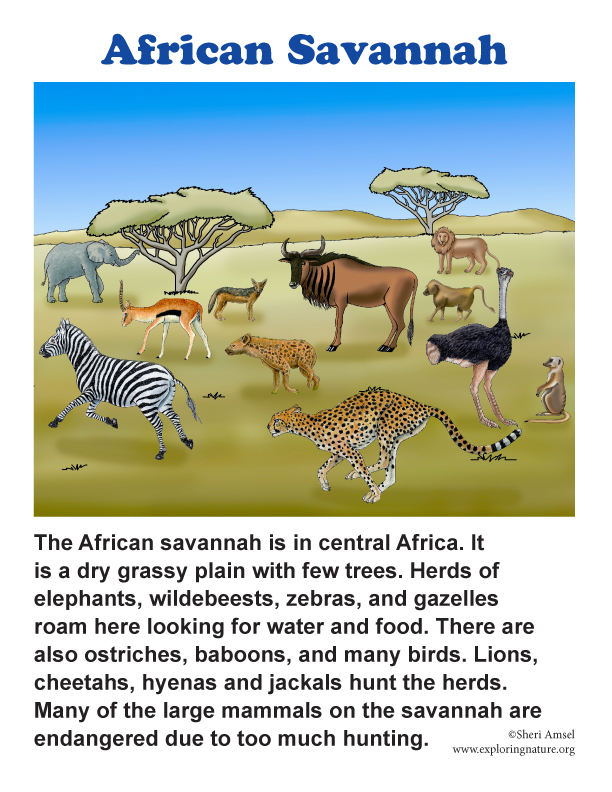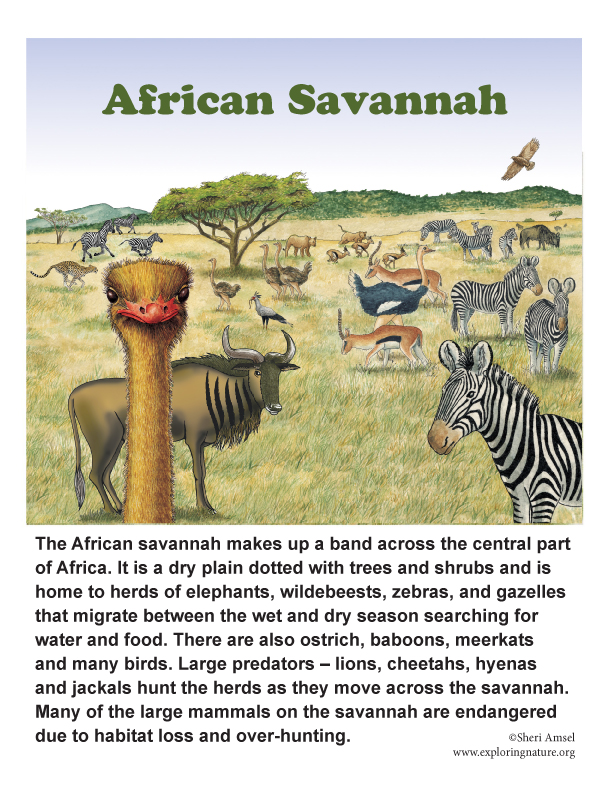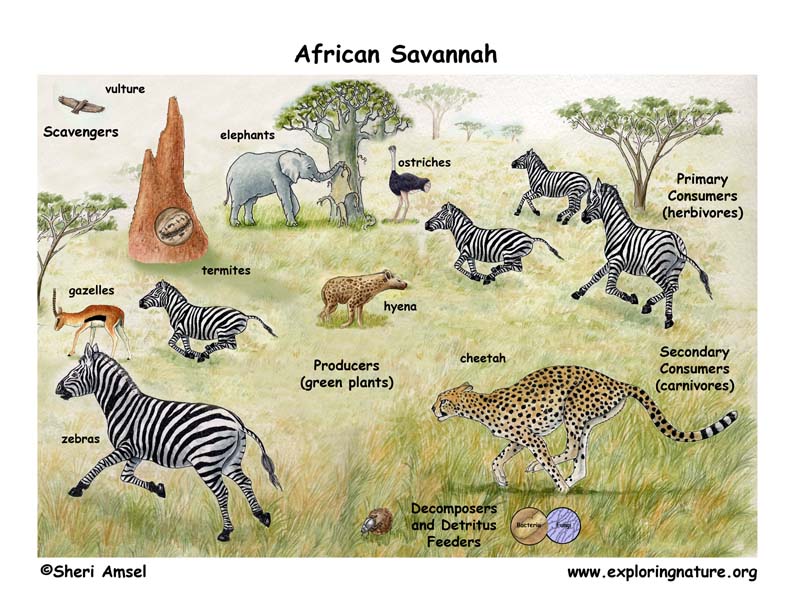

The savanna and veldt make up the central part of Africa in a band across the continent and down the middle into South Africa. Some of the countries with savannah are Kenya, Tanzania, Zambia, Chad, Sudan, Ethiopia, Somalia, Zimbabwe, Mozambique, Botswana, and South Africa.
In Africa, the grasslands are called savannas and range from desert grass plains to those of trees and bushes. The veldt, typical of the interior of South Africa, is a vast area of treeless grassland. Together, this open country is home to many of the world's largest land animals.
The cheetah is the fastest land animal in the world, but it cannot run that fast for long. The lions hunt differently than the cheetah. Members of the pride work together to scare a herd of grazing animals, while a lionesses hides in the tall grass waiting to ambush a passing zebra or gazelle.
When the animal is dead, the lions take turns feeding on it and guarding it while others in the pride rest or go off to drink. Jackals and hyenas are mostly scavengers, feeding on animals that are already dead. Waiting until the big cats have eaten their fill, the jackals and hyenas move in to eat what is left over. They may even scan the sky for circling turkey vulture, other scavengers, that signal an animal nearby has died. Sometimes a big group of hyenas will steal a kill from a lion or kill an animal themselves.
With few trees to slow them down, animals can run great distances on the veldt. The ostrich's seven-foot height and good eyesight give it a great advantage in seeing predators from far off. If danger is spotted, it runs! Animals on the veldt often travel in large herds. The more there are to watch and sniff the air for danger, the safer they are. That is why it is not unusual to see herds of ostriches, zebras, gazelles, and wildebeests traveling together. Living in groups is also a good way to search for food and teach the young.
The termite is one of Africa's smaller animals, but it builds its home so large that they can be seen all across the savanna. The dung beetle builds its round nest in the droppings of other animals. Then it lays its eggs inside. As the offspring develop, they eat their way out of the nest. A common bird of the savanna is the weaverbird. Using long stems of grass, they weave great hanging nests. On the ground the secretary bird, named for its black-and-white suit and quill-like head feathers, hunts for mice and snakes to eat. From above, the brown harrier eagle circles, scanning the hot African plain. As always, life here is a race to find food without becoming someone else's meal.
There are few trees on the African plain, just some acacia, baobab and palm trees, among plenty of grass. Cheetahs view the vast plain from the branches of the acacia tree. A thirsty elephant tears apart a baobab tree to eat the spongy, moist inner wood.
Related Activity:
Draw an African Grassland
African Savannah Animals Coloring Page
African Savanna Animal Word Search (Primary)
African Savanna Animal Word Search (Middle)
African Savanna Word Search (Adult)
Related Testing and Assessment:
African Savannah Food Web Activity
African Savanna - Read and React Quiz
African Savannah Labeling Page
African Savannah Animals Labeling Page
Related Visual Aid:
Download Hi-Res B&W Diagram
Download Hi-Res In-Habitat Poster
Download Hi-Res Color Diagram
When you research information you must cite the reference. Citing for websites is different from citing from books, magazines and periodicals. The style of citing shown here is from the MLA Style Citations (Modern Language Association).
When citing a WEBSITE the general format is as follows.
Author Last Name, First Name(s). "Title: Subtitle of Part of Web Page, if appropriate." Title: Subtitle: Section of Page if appropriate. Sponsoring/Publishing Agency, If Given. Additional significant descriptive information. Date of Electronic Publication or other Date, such as Last Updated. Day Month Year of access < URL >.
Amsel, Sheri. "African Veldt and Savanna" Exploring Nature Educational Resource ©2005-2024. December 13, 2024
< http://www.exploringnature.org/db/view/African-Veldt-and-Savannah >
